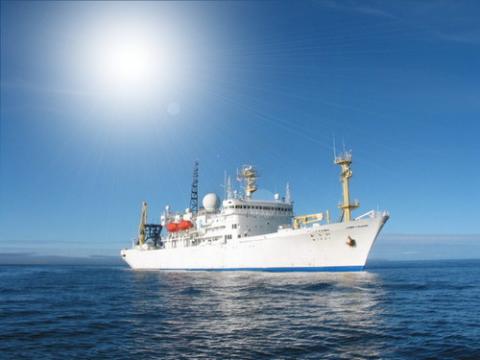According to the vessel owners Japan Agency for Marine-Earth Science and Technology (JAMSTEC), RV Mirai is “the world’s largest oceanographic vessel that can conduct large area and long duration observations”. At 10,727t displacement and 130m in length, she is certainly at the top of her food chain. The Mirai was originally built as the nuclear powered demonstration ship Mutsu, however she was soon retired from that service. In 1997 she was converted to the conventionally powered queen of the Japanese research fleet she is today. Mirai is not fully DP rated, though with joy stick control of twin rudders, twin CCP propellors on a diesel electric hybrid propulsion motor system. two bow thrusters and a stern thruster she can maintain station in severe conditions.
With a ship’s crew of 34 and space for 56 researchers and technicians, the Mirai is operated for JAMSTEC by Global Ocean Development Inc (GODI) a subsidiary of Nippon Yusen Kabushiki Kaisha (NYK) Line. The officers work on a 4 month on, 2 month off rotation. The technicians are employees of Marine Works Japan, and the senior scientists and researchers can be from JAMSTEC, other Japanese research institutes and universities and occasionally visiting non Japanese researchers.
RV Mirai is fitted with 13 permanent labs and often carries up to four containerized laboratories. She is capable of underway deep bottom topography survey using hull mounted mult-beam sonar as well as sub-bottom geological profiling and in water column current profiling. Above the ocean the Mirai conducts ongoing upper air and meteorological study via automated radiosonde and ozonosonde balloon launch and onboard doppler radar tracking. A through ship optical fibre capable links all labs and data collection computers to onboard servers that allows for near real time assessment and sharing of data. Her 36 bottle rosette is deployed from a custom Dynacon crane, while the aft mounted 22ton SWL A-Frame is designed to launch and recovery deep water Ocean Data Acquisition System (ODAS) TRITON buoys and a variety of other scientific equipment. She is also fitted with an 11 ton gallows crane, 7 smaller observation winches, 3 traction winches for mooring recoveries, a 3 ton articulated deck crane and a 10 ton jib deck crane.
A very unique feature onboard the Mirai is a computer control mechanical ant-roll device. Accelerometers sense vessel roll and computer controled drive motors that move massive rail mounted weights to counter act roll extremely effectively permitting overside data collection in extreme sea conditions.
The Mirai is a very suitable vessel to conduct prolonged research in harsh environments such as the Arctic and last year, the Antarctic. She can support large research teams with a large well trained and experienced crew and technicians and the finest state of the art navigation equipment. For ice operations, in addition to conventional S and X band Radars, the Mirai has Rutter Sigma 5 Ice Navigator, and infrared ice view cameras.
Capt David (Duke) Snider
Ice Navigator
RV Mirai

